YAMAHA FJR1300AS 2015 Repair Manual
Manufacturer: YAMAHA, Model Year: 2015, Model line: FJR1300AS, Model: YAMAHA FJR1300AS 2015Pages: 124, PDF Size: 3.39 MB
Page 61 of 124
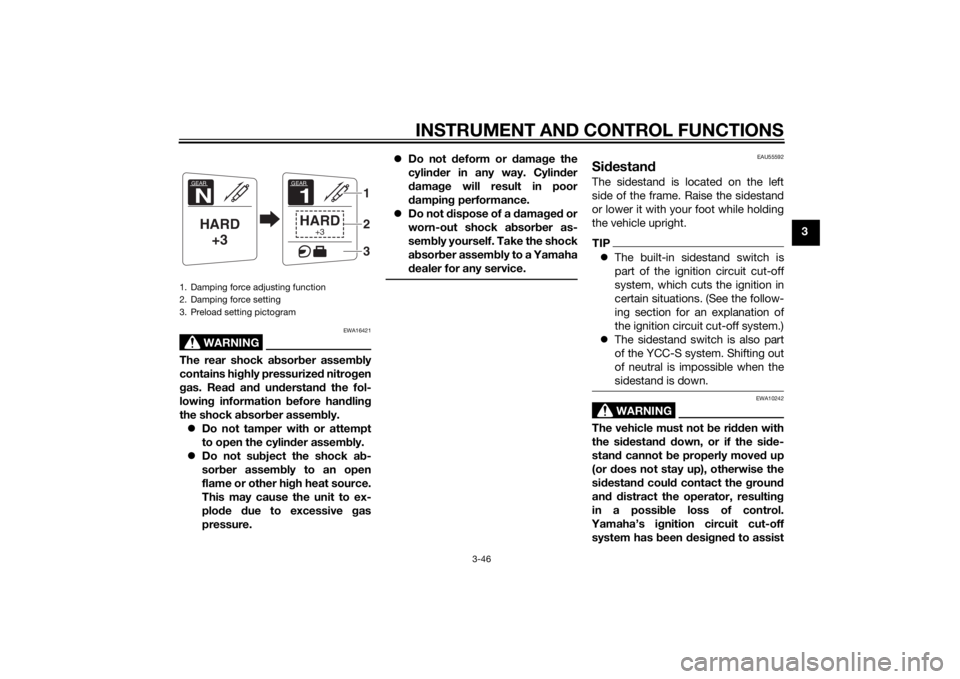
INSTRUMENT AND CONTROL FUNCTIONS
3-46
3
WARNING
EWA16421
The rear shock absorber assembly
contains highly pressurized nitrogen
gas. Read and understand the fol-
lowing information before handling
the shock absorber assembly.
Do not tamper with or attempt
to open the cylinder assembly.
Do not subject the shock ab-
sorber assembly to an open
flame or other high heat source.
This may cause the unit to ex-
plode due to excessive gas
pressure.Do not deform or damage the
cylinder in any way. Cylinder
damage will result in poor
damping performance.
Do not dispose of a damaged or
worn-out shock ab
sorber as-
sembly yourself. Take the shock
absorber assembly to a Yamaha
dealer for any service.
EAU55592
SidestandThe sidestand is located on the left
side of the frame. Raise the sidestand
or lower it with your foot while holding
the vehicle upright.TIPThe built-in sidestand switch is
part of the ignition circuit cut-off
system, which cuts the ignition in
certain situations. (See the follow-
ing section for an explanation of
the ignition circuit cut-off system.)
The sidestand switch is also part
of the YCC-S system. Shifting out
of neutral is impossible when the
sidestand is down.
WARNING
EWA10242
The vehicle must not be ridden with
the sidestand down, or if the side-
stand cannot be properly moved up
(or does not stay up), otherwise the
sidestand could contact the ground
and distract the operator, resulting
in a possible loss of control.
Yamaha’s ignition circuit cut-off
system has been designed to assist
1. Damping force adjusting function
2. Damping force setting
3. Preload setting pictogram
GEARNHARD
+3
GEAR1HARD
+3
123
U1MDE1E0.book Page 46 Monday, July 28, 2014 10:48 AM
Page 62 of 124

INSTRUMENT AND CONTROL FUNCTIONS
3-47
3the operator in fulfilling the respon-
sibility of raising the sidestand be-
fore starting off. Therefore, check
this system regularly and have a
Yamaha dealer repair it if it does not
function properly.
EAU55362
Ignition circuit cut-off systemThe ignition circuit cut-off system
(comprising the sidestand switch and
brake light switches) has the following
functions.
It prevents starting when the side-
stand is up, but neither brake is
applied.
It prevents starting when either
brake is applied, but the sidestand
is still down.
It cuts the running engine when
the sidestand is moved down.
Periodically check the operation of the
ignition circuit cut-off system accord-
ing to the following procedure.
U1MDE1E0.book Page 47 Monday, July 28, 2014 10:48 AM
Page 63 of 124
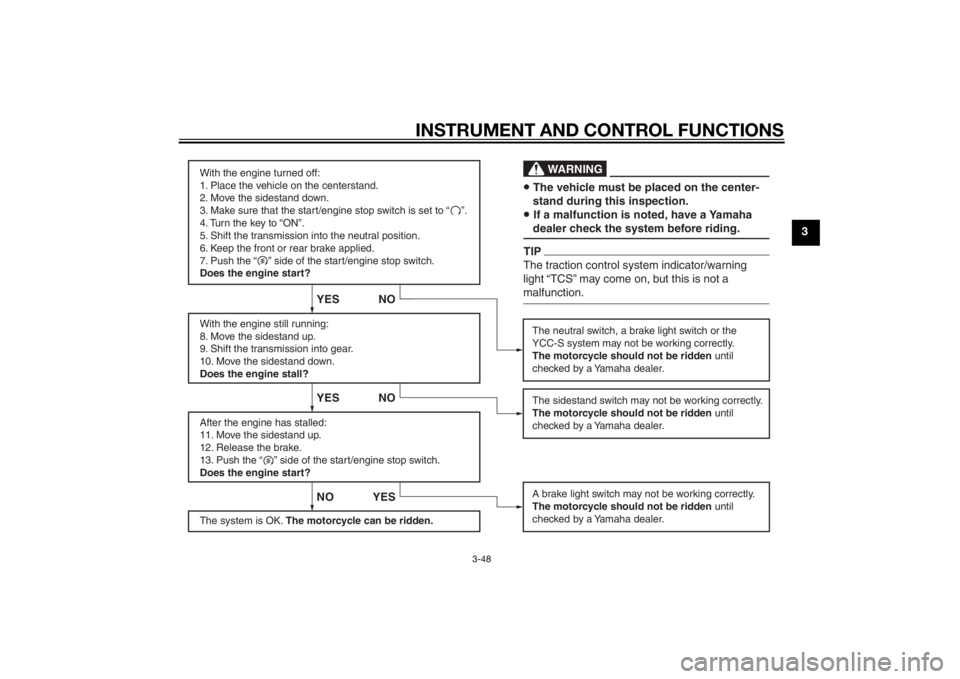
INSTRUMENT AND CONTROL FUNCTIONS
3-48
3
With the engine turned off:
1. Place the vehicle on the centerstand.
2. Move the sidestand down.
3. Make sure that the start/engine stop switch is set to “ ”.
4. Turn the key to “ON”.
5. Shift the transmission into the neutral position.
6. Keep the front or rear brake applied.
7. Push the “ ” side of the start/engine stop switch.
Does the engine start?
With the engine still running:
8. Move the sidestand up.
9. Shift the transmission into gear.
10. Move the sidestand down.
Does the engine stall?
After the engine has stalled:
11. Move the sidestand up.
12. Release the brake.
13. Push the “ ” side of the start/engine stop switch.
Does the engine start?
The system is OK. The motorcycle can be ridden.
NO
YES YES NO YES
NO
The neutral switch, a brake light switch or the
YCC-S system may not be working correctly.
The motorcycle should not be ridden until
checked by a Yamaha dealer.
A brake light switch may not be working correctly.
The motorcycle should not be ridden until
checked by a Yamaha dealer.The sidestand switch may not be working correctly.
The motorcycle should not be ridden until
checked by a Yamaha dealer.• The vehicle must be placed on the center-
stand during this inspection.• If a malfunction is noted, have a Yamaha
dealer check the system before riding.
WA R N I N G
TIPThe traction control system indicator/warning
light “TCS” may come on, but this is not a
malfunction.
U1MDE1E0.book Page 48 Monday, July 28, 2014 10:48 AM
Page 64 of 124
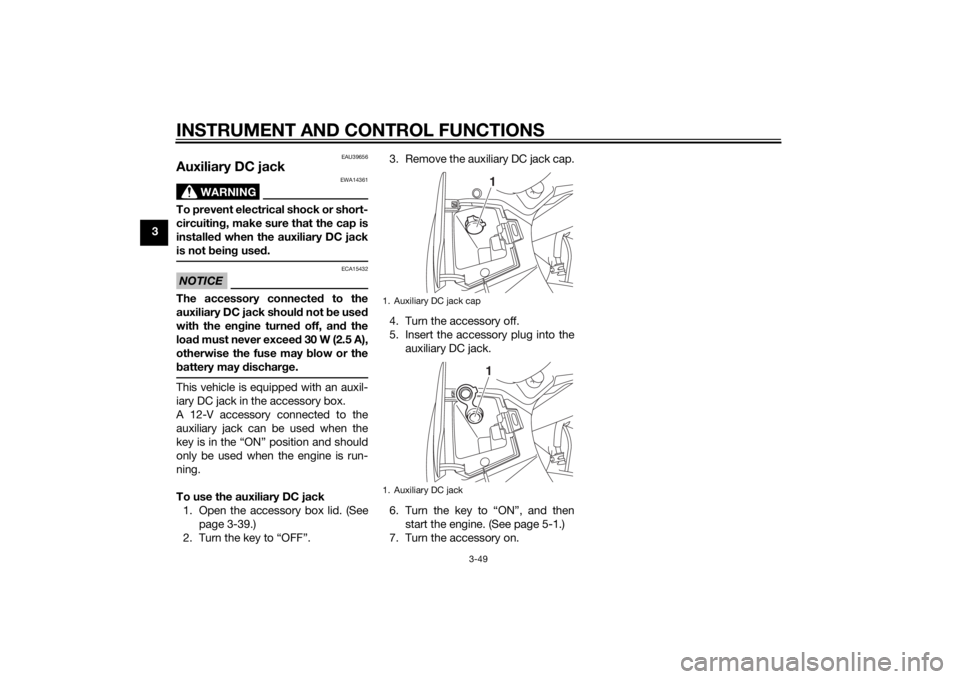
INSTRUMENT AND CONTROL FUNCTIONS
3-49
3
EAU39656
Auxiliary DC jack
WARNING
EWA14361
To prevent electrical shock or short-
circuiting, make sure that the cap is
installed when the auxiliary DC jack
is not being used.NOTICE
ECA15432
The accessory connected to the
auxiliary DC jack should not be used
with the engine turned off, and the
load must never exceed 30 W (2.5 A),
otherwise the fuse may blow or the
battery may discharge.This vehicle is equipped with an auxil-
iary DC jack in the accessory box.
A 12-V accessory connected to the
auxiliary jack can be used when the
key is in the “ON” position and should
only be used when the engine is run-
ning.
To use the auxiliary DC jack
1. Open the accessory box lid. (See
page 3-39.)
2. Turn the key to “OFF”.3. Remove the auxiliary DC jack cap.
4. Turn the accessory off.
5. Insert the accessory plug into the
auxiliary DC jack.
6. Turn the key to “ON”, and then
start the engine. (See page 5-1.)
7. Turn the accessory on.
1. Auxiliary DC jack cap
1. Auxiliary DC jack
11
U1MDE1E0.book Page 49 Monday, July 28, 2014 10:48 AM
Page 65 of 124
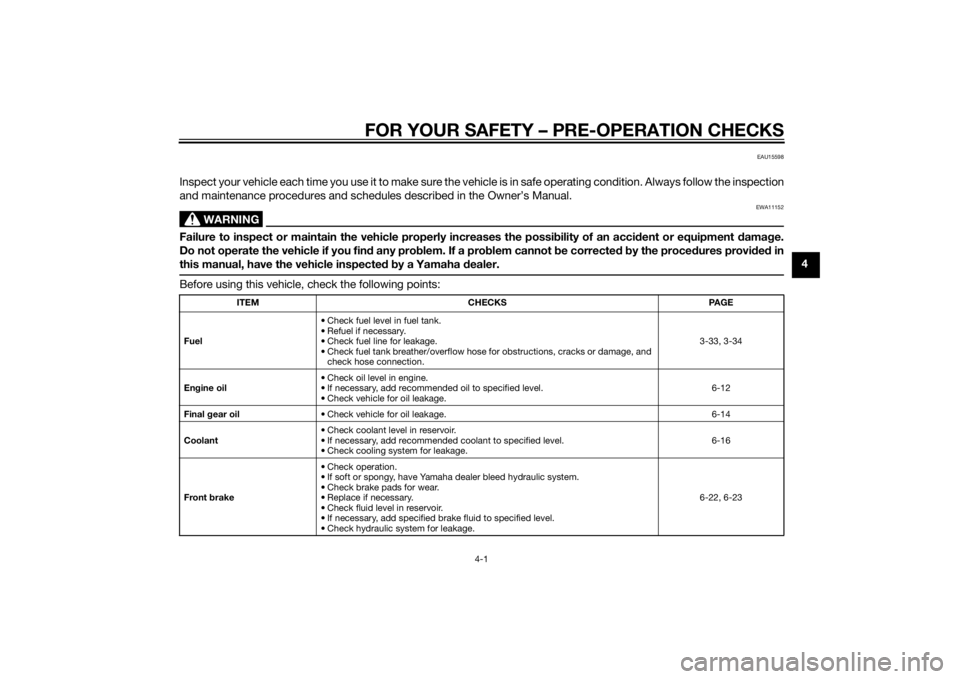
FOR YOUR SAFETY – PRE-OPERATION CHECKS
4-1
4
EAU15598
Inspect your vehicle each time you use it to make sure the vehicle is in safe operating condition. Always follow the inspection
and maintenance procedures and schedules described in the Owner’s Manual.
WARNING
EWA11152
Failure to inspect or maintain the vehicle properly increases the possibility of an accident or equipment damage.
Do not operate the vehicle if you find any problem. If a problem cannot be corrected by the procedures provided in
this manual, have the vehicle inspected by a Yamaha dealer.Before using this vehicle, check the following points:
ITEM CHECKS PAGE
Fuel• Check fuel level in fuel tank.
• Refuel if necessary.
• Check fuel line for leakage.
• Check fuel tank breather/overflow hose for obstructions, cracks or damage, and
check hose connection.3-33, 3-34
Engine oil• Check oil level in engine.
• If necessary, add recommended oil to specified level.
• Check vehicle for oil leakage.6-12
Final gear oil• Check vehicle for oil leakage. 6-14
Coolant• Check coolant level in reservoir.
• If necessary, add recommended coolant to specified level.
• Check cooling system for leakage.6-16
Front brake• Check operation.
• If soft or spongy, have Yamaha dealer bleed hydraulic system.
• Check brake pads for wear.
• Replace if necessary.
• Check fluid level in reservoir.
• If necessary, add specified brake fluid to specified level.
• Check hydraulic system for leakage.6-22, 6-23
U1MDE1E0.book Page 1 Monday, July 28, 2014 10:48 AM
Page 66 of 124

FOR YOUR SAFETY – PRE-OPERATION CHECKS
4-2
4
Rear brake• Check operation.
• If soft or spongy, have Yamaha dealer bleed hydraulic system.
• Check brake pads for wear.
• Replace if necessary.
• Check fluid level in reservoir.
• If necessary, add specified brake fluid to specified level.
• Check hydraulic system for leakage.6-22, 6-23
YCC-S clutch• Check operation.
• Check fluid level in reservoir.
• If necessary, add specified brake fluid to specified level.
• Check hydraulic system for leakage.6-21, 6-23
Throttle grip• Make sure that operation is smooth.
• Check throttle grip free play.
• If necessary, have Yamaha dealer adjust throttle grip free play and lubricate ca-
ble and grip housing.6-18, 6-25
Control cables• Make sure that operation is smooth.
• Lubricate if necessary.6-25
Wheels and tires•Check for damage.
• Check tire condition and tread depth.
• Check air pressure.
• Correct if necessary.6-18, 6-21
Brake and shift pedals• Make sure that operation is smooth.
• Lubricate pedal pivoting points if necessary.6-26
Brake lever• Make sure that operation is smooth.
• Lubricate lever pivoting point if necessary.6-26
Centerstand, sidestand• Make sure that operation is smooth.
• Lubricate pivots if necessary.6-27
Chassis fasteners• Make sure that all nuts, bolts and screws are properly tightened.
• Tighten if necessary.—
Instruments, lights, signals
and switches• Check operation.
• Correct if necessary.— ITEM CHECKS PAGE
U1MDE1E0.book Page 2 Monday, July 28, 2014 10:48 AM
Page 67 of 124

FOR YOUR SAFETY – PRE-OPERATION CHECKS
4-3
4
Sidestand switch • Check operation of ignition circuit cut-off system.
• If system is not working correctly, have Yamaha dealer check vehicle.3-46 ITEM CHECKS PAGE
U1MDE1E0.book Page 3 Monday, July 28, 2014 10:48 AM
Page 68 of 124
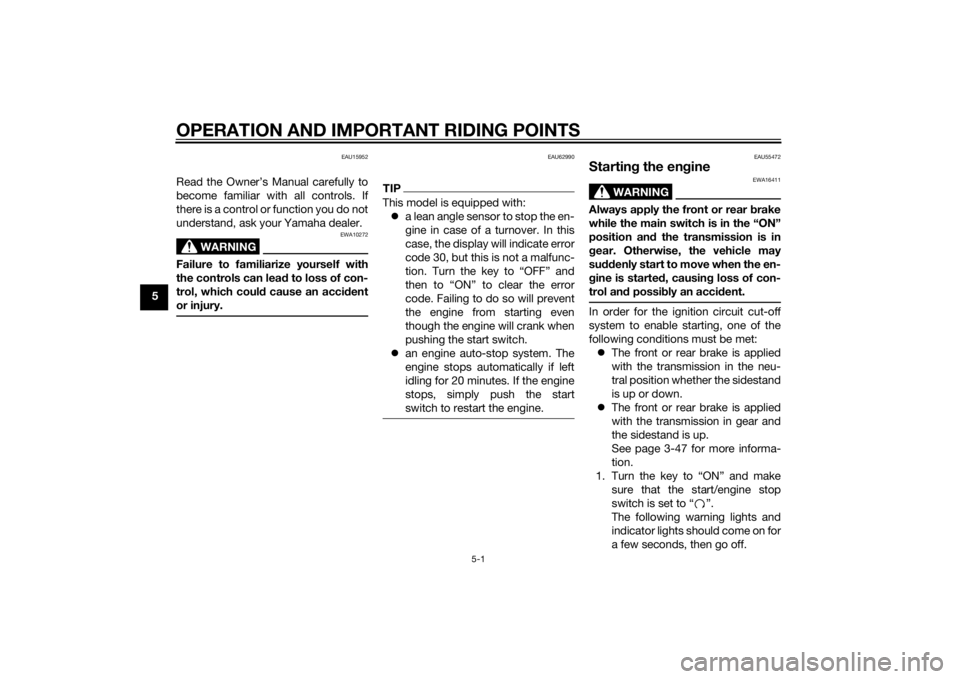
OPERATION AND IMPORTANT RIDING POINTS
5-1
5
EAU15952
Read the Owner’s Manual carefully to
become familiar with all controls. If
there is a control or function you do not
understand, ask your Yamaha dealer.
WARNING
EWA10272
Failure to familiarize yourself with
the controls can lead to loss of con-
trol, which could cause an accident
or injury.
EAU62990
TIPThis model is equipped with:
a lean angle sensor to stop the en-
gine in case of a turnover. In this
case, the display will indicate error
code 30, but this is not a malfunc-
tion. Turn the key to “OFF” and
then to “ON” to clear the error
code. Failing to do so will prevent
the engine from starting even
though the engine will crank when
pushing the start switch.
an engine auto-stop system. The
engine stops automatically if left
idling for 20 minutes. If the engine
stops, simply push the start
switch to restart the engine.
EAU55472
Starting the engine
WARNING
EWA16411
Always apply the front or rear brake
while the main switch is in the “ON”
position and the transmission is in
gear. Otherwise, the vehicle may
suddenly start to move when the en-
gine is started, causing loss of con-
trol and possibly an accident.In order for the ignition circuit cut-off
system to enable starting, one of the
following conditions must be met:
The front or rear brake is applied
with the transmission in the neu-
tral position whether the sidestand
is up or down.
The front or rear brake is applied
with the transmission in gear and
the sidestand is up.
See page 3-47 for more informa-
tion.
1. Turn the key to “ON” and make
sure that the start/engine stop
switch is set to “ ”.
The following warning lights and
indicator lights should come on for
a few seconds, then go off.
U1MDE1E0.book Page 1 Monday, July 28, 2014 10:48 AM
Page 69 of 124
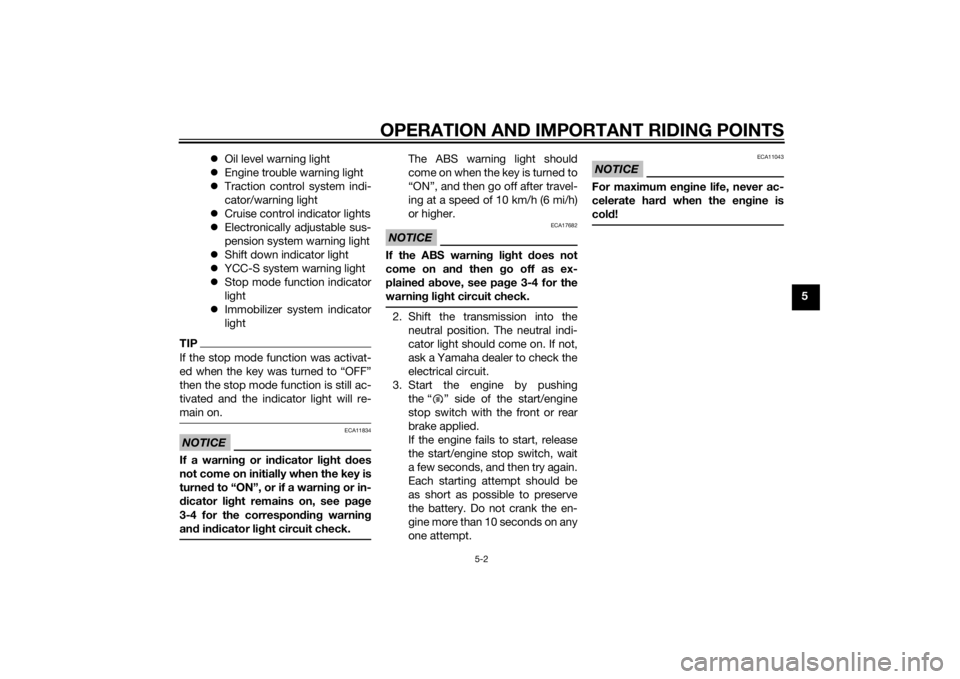
OPERATION AND IMPORTANT RIDING POINTS
5-2
5 Oil level warning light
Engine trouble warning light
Traction control system indi-
cator/warning light
Cruise control indicator lights
Electronically adjustable sus-
pension system warning light
Shift down indicator light
YCC-S system warning light
Stop mode function indicator
light
Immobilizer system indicator
light
TIPIf the stop mode function was activat-
then the stop mode function is still ac-
tivated and the indicator light will re-
main on.NOTICE
ECA11834
If a warning or indicator light does
not come on initially when the key is
turned to “ON”, or if a warning or in-
dicator light remains on, see page
3-4 for the corresponding warning
and indicator light circuit check.
The ABS warning light should
come on when the key is turned to
“ON”, and then go off after travel-
ing at a speed of 10 km/h (6 mi/h)
or higher.
NOTICE
ECA17682
If the ABS warning light does not
come on and then go off as ex-
plained above, see page 3-4 for the
warning light circuit check.2. Shift the transmission into the
neutral position. The neutral indi-
cator light should come on. If not,
ask a Yamaha dealer to check the
electrical circuit.
3. Start the engine by pushing
the “ ” side of the start/engine
stop switch with the front or rear
brake applied.
If the engine fails to start, release
the start/engine stop switch, wait
a few seconds, and then try again.
Each starting attempt should be
as short as possible to preserve
the battery. Do not crank the en-
gine more than 10 seconds on any
one attempt.
NOTICE
ECA11043
For maximum engine life, never ac-
celerate hard when the engine is
cold!
U1MDE1E0.book Page 2 Monday, July 28, 2014 10:48 AM
Page 70 of 124
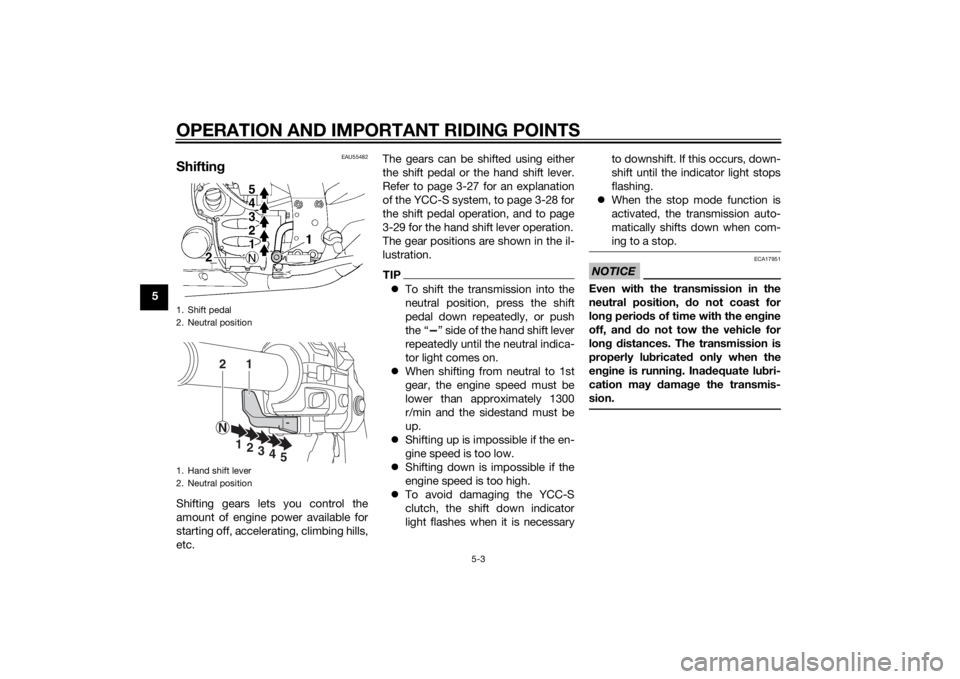
OPERATION AND IMPORTANT RIDING POINTS
5-3
5
EAU55482
ShiftingShifting gears lets you control the
amount of engine power available for
starting off, accelerating, climbing hills,
etc.The gears can be shifted using either
the shift pedal or the hand shift lever.
Refer to page 3-27 for an explanation
of the YCC-S system, to page 3-28 for
the shift pedal operation, and to page
3-29 for the hand shift lever operation.
The gear positions are shown in the il-
lustration.
TIPTo shift the transmission into the
neutral position, press the shift
pedal down repeatedly, or push
the “ ” side of the hand shift lever
repeatedly until the neutral indica-
tor light comes on.
When shifting from neutral to 1st
gear, the engine speed must be
lower than approximately 1300
r/min and the sidestand must be
up.
Shifting up is impossible if the en-
gine speed is too low.
Shifting down is impossible if the
engine speed is too high.
To avoid damaging the YCC-S
clutch, the shift down indicator
light flashes when it is necessaryto downshift. If this occurs, down-
shift until the indicator light stops
flashing.
When the stop mode function is
activated, the transmission auto-
matically shifts down when com-
ing to a stop.
NOTICE
ECA17951
Even with the transmission in the
neutral position, do not coast for
long periods of time with the engine
off, and do not tow the vehicle for
long distances. The transmission is
properly lubricated only when the
engine is running. Inadequate lubri-
cation may damage the transmis-
sion.
1. Shift pedal
2. Neutral position
1. Hand shift lever
2. Neutral position
1
2N
1
2
3
4
5
U1MDE1E0.book Page 3 Monday, July 28, 2014 10:48 AM